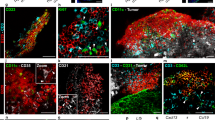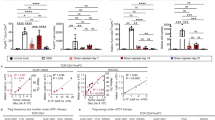Abstract
Background
CD4+CD25+ regulatory T cells (Treg), which constitute about 2–3% of CD4+ human T cells, are the main contributors to the maintenance of immune tolerance. Cancer patients, including glioblastoma patients, bear increased number of circulating and tumor infiltrating Treg that exert functional inhibition on tumor-specific T cells. Temozolomide (TMZ) is one of the most effective chemotherapeutic agents in glioblastoma (GBM). Lymphopenia is a common side effect of TMZ treatment, but to what extent the Treg compartment is affected by this chemotherapy has been poorly investigated. We therefore studied the impact of various TMZ regimens on Treg cell population in a TMZ-resistant rat model of glioma.
Methods
RG2 glioma cells were implanted s.c. in Fischer rats. Twelve days after tumor implantation, TMZ was administered orally with schedules designed to mimic the TMZ regimens currently used in humans: 30 mg/kg per day for 5 days, or 10 mg/kg per day for 21 days. In addition, two metronomic regimens with low-dose TMZ (2 and 0.5 mg/kg per day for 21 days) were evaluated. Splenocytes and tumor infiltrating lymphocytes were analysed by flow cytometry using CD3, CD4, CD25, and Foxp3 mAbs. Statistical significance was determined by the Mann–Whitney U test, the Student’s t test or the ANOVA test.
Results
In the spleen of tumor-bearing animals, low-dose TMZ metronomic regimens (0.5 and 2 mg/kg for 21 days) induced a significant decrease of Treg/CD4+ ratios (13 ± 2; p < 0.01, 14 ± 3; p < 0.05, respectively, vs. 19 ± 5 for controls). On the contrary, high-dose TMZ regimen (10 mg/kg per day for 21 days or 30 mg/kg for 5 days) did not significantly modify the percentage of Treg/CD4+. Within tumors, treatment with the 0.5 mg/kg TMZ regimen induced a slight and nearly significant decrease in the percentage of Treg/CD4+ after a 2 to 3-week treatment (24 ± 9 vs. 35 ± 11; p = 0.06). Treg depletion induced by the low-dose metronomic TMZ regimen was accompanied by a decreased suppressive function of the remaining Treg cells as assessed by an in vitro functional test. Treatment with 0.5 mg/kg metronomic TMZ reduced tumor progression when compared to untreated animals but the effect did not reach statistical significance, indicating that Treg depletion alone is not sufficient to significantly impact tumor growth in our model of fully established tumor.
Conclusions
A low-dose metronomic TMZ regimen, but not a standard TMZ regimen, reduced the number of circulating Tregs. These results can have clinical applications for immunotherapeutic approaches in GBM.





Similar content being viewed by others
References
Stupp R, Mason WP, van den Bent MJ, Weller M, Fisher B, Taphoorn MJ, Belanger K, Brandes AA, Marosi C, Bogdahn U, Curschmann J, Janzer RC, Ludwin SK, Gorlia T, Allgeier A, Lacombe D, Cairncross JG, Eisenhauer E, Mirimanoff RO, European Organisation for Research, Treatment of Cancer Brain Tumor, Radiotherapy Groups, National Cancer Institute of Canada Clinical Trials Group (2005) Radiotherapy plus concomitant and adjuvant temozolomide for glioblastoma. N Engl J Med 352(10):987–996
Yung WK, Albright RE, Olson J et al (2000) A phase II study of temozolomide versus procarbazine in patients with glioblastoma multiforme at first relapse. Br J Cancer 83:588–593
Friedman HS, Kerby T, Calvert H (2000) Temozolomide and treatment of malignant glioma. Clin Cancer Res 6(7):2585–2597
Behin A, Hoang-Xuan K, Carpentier AF, Delattre JY (2003) Primary brain tumours in adults. Lancet 361(9354):323–331
Sakaguchi S (2000) Regulatory T cells: key controllers of immunologic self-tolerance. Cell 101(5):455–458
Gupta S, Shang W, Sun Z (2008) Mechanisms regulating the development and function of natural regulatory T cells. Arch Immunol Ther Exp (Warsz) 56(2):85–102
Sakaguchi S, Sakaguchi N, Shimizu J, Yamazaki S, Sakihama T, Itoh M, Kuniyasu Y, Nomura T, Toda M, Takahashi T (2001) Immunologic tolerance maintained by CD25+ CD4+ regulatory T cells: their common role in controlling autoimmunity, tumor immunity, and transplantation tolerance. Immunol Rev 182:18–32
Grauer OM, Nierkens S, Bennink E, Toonen LW, Boon L, Wesseling P, Sutmuller RP, Adema GJ (2007) CD4+FoxP3+ regulatory T cells gradually accumulate in gliomas during tumor growth and efficiently suppress antiglioma immune responses in vivo. Int J Cancer 121(1):95–105
Onizuka S, Tawara I, Shimizu J, Sakaguchi S, Fujita T, Nakayama E (1999) Tumor rejection by in vivo administration of anti-CD25 (interleukin-2 receptor alpha) monoclonal antibody. Cancer Res 59(13):3128–3133
Golgher D, Jones E, Powrie F, Elliott T, Gallimore A (2002) Depletion of CD25+ regulatory cells uncovers immune responses to shared murine tumor rejection antigens. Eur J Immunol 32(11):3267–3275
Fecci PE, Mitchell DA, Whitesides JF, Xie W, Friedman AH, Archer GE, Herndon JE 2nd, Bigner DD, Dranoff G, Sampson JH (2006) Increased regulatory T cell fraction amidst a diminished CD4 compartment explains cellular immune defects in patients with malignant glioma. Cancer Res 66(6):3294–3302
El Andaloussi A, Lesniak MS (2006) An increase in CD4+CD25+FOXP3 + regulatory T cells in tumor-infiltrating lymphocytes of human glioblastoma multiforme. Neuro Oncol 8(3):234–243
Motoyoshi Y, Kaminoda K, Saitoh O, Hamasaki K, Nakao K, Ishii N, Nagayama Y, Eguchi K (2006) Different mechanisms for anti-tumor effects of low- and high-dose cyclophosphamide. Oncol Rep 16(1):141–146
Ghiringhelli F, Menard C, Puig PE, Ladoire S, Roux S, Martin F, Solary E, Le Cesne A, Zitvogel L, Chauffert B (2007) Metronomic cyclophosphamide regimen selectively depletes CD4+CD25+ regulatory T cells and restores T and NK effector functions in end stage cancer patients. Cancer Immunol Immunother 56(5):641–648
Ghiringhelli F, Larmonier N, Schmitt E, Parcellier A, Cathelin D, Garrido C, Chauffert B, Solary E, Bonnotte B, Martin F (2004) CD4+CD25+ regulatory T cells suppress tumor immunity but are sensitive to cyclophosphamide which allows immunotherapy of established tumors to be curative. Eur J Immunol 34(2):336–344
Taieb J, Chaput N, Schartz N, Roux S, Novault S, Ménard C, Ghiringhelli F, Terme M, Carpentier AF, Darrasse-Jèze G, Lemonnier F, Zitvogel L (2006) Chemoimmunotherapy of tumors: cyclophosphamide synergizes with exosome based vaccines. J Immunol 176(5):2722–2729
Grauer OM, Sutmuller RP, van Maren W, Jacobs JF, Bennink E, Toonen LW, Nierkens S, Adema GJ (2008) Elimination of regulatory T cells is essential for an effective vaccination with tumor lysate-pulsed dendritic cells in a murine glioma model. Int J Cancer 122(8):1794–1802
Lutsiak ME, Semnani RT, De Pascalis R, Kashmiri SV, Schlom J, Sabzevari H (2005) Inhibition of CD4(+)25+ T regulatory cell function implicated in enhanced immune response by low-dose cyclophosphamide. Blood 105(7):2862–2868
Review of preclinical toxicity studies of temozolomide. http://www.fda.gov/cder/foi/nda/99/21029_Temodar.htm
Barth RF (1998) Rat brain tumor models in experimental neuro-oncology: the 9L, C6, T9, F98, RG2 (D74), RT-2 and CNS-1 gliomas. J Neurooncol 36(1):91–102
Sankar A, Thomas DG, Darling JL (1999) Sensitivity of short-term cultures derived from human malignant glioma to the anti-cancer drug temozolomide. Anticancer Drugs 10(2):179–185
Shimizu J, Yamazaki S, Sakaguchi S (1999) Induction of tumor immunity by removing CD25+CD4+ T cells: a common basis between tumor immunity and autoimmunity. J Immunol 163(10):5211–5218
Di Paolo NC, Tuve S, Ni S, Hellström KE, Hellström I, Lieber A (2006) Effect of adenovirus-mediated heat shock protein expression and oncolysis in combination with low-dose cyclophosphamide treatment on antitumor immune responses. Cancer Res 66(2):960–969
Dix AR, Brooks WH, Roszman TL, Morford LA (1999) Immune defects observed in patients with primary malignant brain tumors. J Neuroimmunol 100(1–2):216–232
Ghiringhelli F, Ménard C, Terme M, Flament C, Taieb J, Chaput N, Puig PE, Novault S, Escudier B, Vivier E, Lecesne A, Robert C, Blay JY, Bernard J, Caillat-Zucman S, Freitas A, Tursz T, Wagner-Ballon O, Capron C, Vainchencker W, Martin F, Zitvogel L (2005) CD4+CD25+ regulatory T cells inhibit natural killer cell functions in a transforming growth factor-beta-dependent manner. J Exp Med 202(8):1075–1085
Curiel TJ, Coukos G, Zou L, Alvarez X, Cheng P, Mottram P, Evdemon-Hogan M, Conejo-Garcia JR, Zhang L, Burow M, Zhu Y, Wei S, Kryczek I, Daniel B, Gordon A, Myers L, Lackner A, Disis ML, Knutson KL, Chen L, Zou W (2004) Specific recruitment of regulatory T cells in ovarian carcinoma fosters immune privilege and predicts reduced survival. Nat Med 10(9):942–949
Sampson JH, Aldape KD, Gilbert MR, Hassenbusch SJ, Sawaya R, Schmittling B, Archer GE, Mitchell D, Bigner DD, Reardon DA, Heimberger AB (2007) Temozolomide as a vaccine adjuvant in GBM. J Clin Oncol, 2007 In: Proceedings of the ASCO annual meeting, part I, vol 25, No. 18S (June 20 supplement): 2020
Reits EA, Hodge JW, Herberts CA, Groothuis TA, Chakraborty M, Wansley EK, Camphausen K, Luiten RM, de Ru AH, Neijssen J, Griekspoor A, Mesman E, Verreck FA, Spits H, Schlom J, van Veelen P, Neefjes JJ (2006) Radiation modulates the peptide repertoire, enhances MHC class I expression, and induces successful antitumor immunotherapy. J Exp Med 203(5):1259–1271
Zitvogel L, Apetoh L, Ghiringhelli F, André F, Tesniere A, Kroemer G (2008) The anticancer immune response: indispensable for therapeutic success? J Clin Invest 118(6):1991–2001
Acknowledgments
This work was supported by grants from the Agence Nationale de la Recherche (ANR–06-RIB-005-02) and from the Association Oligocyte.
Conflict of interest statement
None.
Author information
Authors and Affiliations
Corresponding author
Rights and permissions
About this article
Cite this article
Banissi, C., Ghiringhelli, F., Chen, L. et al. Treg depletion with a low-dose metronomic temozolomide regimen in a rat glioma model. Cancer Immunol Immunother 58, 1627–1634 (2009). https://doi.org/10.1007/s00262-009-0671-1
Received:
Accepted:
Published:
Issue Date:
DOI: https://doi.org/10.1007/s00262-009-0671-1




